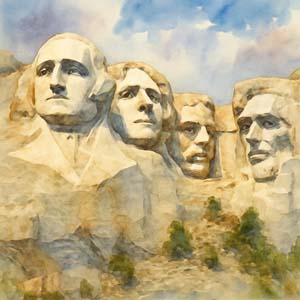— Gutzon Borglum
 As the passionate creator of some of the world's largest sculptures, American artist Gutzon Borglum (1867–1941) studied in San Francisco and Paris where he was inspired by the great Auguste Rodin.
As the passionate creator of some of the world's largest sculptures, American artist Gutzon Borglum (1867–1941) studied in San Francisco and Paris where he was inspired by the great Auguste Rodin.
Borglum accepted his first commission in 1901, that of the statue of Abraham Lincoln in the rotunda of the Capitol Building in Washington D.C.
About life's grandeur, the sensitive Borglum once said: "The heavy pipes in an organ will, rightly played... make everything else on Earth seem unimportant."
He thought big and dreamed big. His most famous work was the colossal stone carving on the granite cliffs of Mount Rushmore in the Black Hills of Keystone, South Dakota.
The massive sculpture honored Presidents George Washington, Thomas Jefferson, Abraham Lincoln, and Theodore Roosevelt.
"(Borglum) was a hyperactive man who traveled in the middle of a self-generated whirlwind," explained biographer Rex Allan Smith. Borglum once called his critics "horseflies."
With a crew of 400, Borglum worked for 14 years (1927–1941) on the "Shrine of Democracy"—blasting, drilling, and carving the 60-foot faces into the 6,000-foot mountain.
According to Borglum, the Memorial was "built into, cut into, the crust of this Earth so that those records would have to melt or by wind be worn to dust before the record... could, as Lincoln said, 'perish from the Earth.'"
He completed the first face, that of Washington, in 1930. At the dedication, Borglum reflected, “Let us place there, carved high, as close to the heavens as we can, the words of our leaders, their faces, to show posterity what manner of men they were.”
His towering vision was more than mere stone — it was a bold prayer in granite, a legacy of courage and character etched into the sky for generations to feel and remember.
 Let your legacy be carved from conviction--vision raised skyward. 🗿
Let your legacy be carved from conviction--vision raised skyward. 🗿
